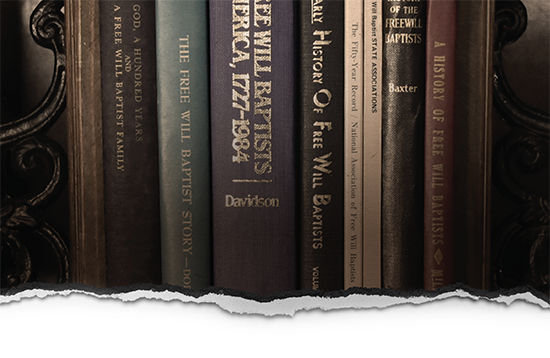
October-November 2021
Celebrating 100 Issues of ONE Magazine
------------------
|





History of Our Histories
By Phillip T. Morgan
If a stranger asked who you are, how would you respond? You might begin with your name and occupation, but you would quickly turn to history, explaining where you came from and to whom you are connected biologically, intellectually, and spiritually. History tells us who we are, helps us explain ourselves to others, and gives us direction for the future.
Denominational history serves the same function. With a strong identity comes the confidence to be ourselves in a culture pulling us simultaneously in a thousand directions. Furthermore, knowledge of our history helps us communicate the truth of the gospel. Confident and articulate, we can face the future, trusting our past will give us wise counsel as we face new challenges.
Not surprisingly, the past is a contested place. Historians have understood the story of Free Will Baptists in many ways. These approaches often overlap and are informed by earlier histories. Consequently, a broad understanding of our historiography (how people have understood and recorded history) is helpful. The following is a broad outline of a Free Will Baptist historiography since the formation of the denomination in 1935, though many wonderful resources are omitted due to space. It is hoped this guide will lead to further reading and encourage Free Will Baptists to clarify our identity and prepare for a unified future. [1]
The National Association of Free Will Baptists
Prior to the formation of the National Association in 1935, histories about Free Will Baptists focused on either the Palmer (Southern) or the Randall (Northern) Movements individually. Histories of the Palmer Movement highlighted genealogical and doctrinal connections to the English General Baptists who immigrated to North Carolina in the seventeenth century. Narratives of the Randall Movement focused on their founding in the New England pietistic revivalism of the eighteenth century—and especially biographies of important leaders. While both sides were aware of the other and occasionally mentioned one another or corresponded, they remained distinct groups, and their histories reflect distinguishable characteristics.
After 1935, new histories attempted to bring the two narratives together. Damon Dodd’s The Free Will Baptist Story (1956) was the first major attempt along these lines. Dodd highlighted the doctrines of Arminianism and believer’s baptism over other doctrines to emphasize the similarities between the two groups. Dodd recognized the Palmer connection to England, drawing heavily from George Paschal’s masterful History of North Carolina Baptists (1930) to inform his early narrative of North Carolina Free Will Baptists.
Other historians focused on more specific narratives. Some, like Paul Woolsey in God, A Hundred Years, and a Free Will Baptist Family (1949), wedded biography, family history, and associational history. Others focused on regional and state activity, spurred by the Historical Commission’s first publication, History of Free Will Baptist Associations (1976), edited by Robert E. Picirilli. Over time, these detailed accounts of various state associations enhanced our historical understanding significantly.
William F. Davidson and Michael Pelt
Still, Free Will Baptists lacked an academic, well-researched treatment of the movement. William F. Davidson filled this void with An Early History of Free Will Baptists (1974). By 1985, he had expanded his research to bring the narrative forward to the late twentieth century in The Free Will Baptists in America, 1727–1984. [2] This volume engaged myriad sources, including associational minutes, official histories, court records, and broader histories by non-Free Will Baptists.
Like Dodd, Davidson attempted to explain the movement’s history considering its unification.
However, Davidson avoided Dodd’s oversimplification. Instead, Davidson argued the relationship between the two movements prior to the 1911 Northern Baptist merger was sporadic and largely limited to organizational models and theological terminology. Though the Randall Movement plays a significant role in his narrative, he gave prominence to the Palmer Movement.
Davidson’s work contained two particularly important developments. First, he revealed the missing connection between English General Baptists and North Carolina General and Free Will Baptists. Working with North Carolina State Archivist George Stevenson, Davidson learned Palmer’s father-in-law was named Benjamin Laker. Stevenson traced Laker back to England and narrowed the time frame for his conversion to General Baptist doctrine. Palmer Movement historians and Baptist historians had affirmed this link since the nineteenth century but lacked the necessary sources to outline the connection in full. Thus, Davidson’s history placed the deep research of Stevenson within the broader context of Free Will Baptist history.
Second, Davidson made the first attempt to explain the 1962 denominational split in North Carolina. He argued that denominational polity (structure) was well known to everyone in 1935 and had been reaffirmed in 1955. Within that context, he argued the North Carolina State Convention leaders who claimed a “connectional” form of government during the Edgemont Church dispute knowingly contradicted the denomination’s stance on the matter.
Though Davidson attempted an evenhanded treatment, he presented the North Carolina State Convention as the offending party that refused to engage with a patient and conciliatory National Association.
Undoubtedly, Michael Pelt authored A History of Original Free Will Baptists (1996), at least in part, as a response to Davidson’s portrayal of these events leading up to the split. Pelt, prominent in the North Carolina State Convention (also known as Original Free Will Baptists), provided a detailed analysis of the development of Free Will Baptists. Like Dodd and Davidson, he attempted to explain the relationship between the Palmer and Randall Movements prior to the twentieth century. Strongly emphasizing the connection with English General Baptists, Pelt gave less credence to the influence of the Randall Movement but did not dismiss the movement thecompletely.
More importantly, Pelt argued the issue of church polity was not settled in 1935. According to his book, North Carolina Free Will Baptists historically practiced a connectional form of church government inherited from the English General Baptists. In his narrative, certain denominational leaders forced the issue of church polity and ousted the connectional North Carolinians.
For those who navigated such troubled waters in person,
a balanced narrative may be impossible, but their perspective remains valuable to future historians.
History in the Twenty-first Century
Since 2000, Free Will Baptist history has diverged into three distinct tracks. Two approaches expanded on earlier models. State histories continue to be written with increased detail and new information. Microhistories are another prominent historiographical form that continue to emerge. Many are biographical, but others address less personality-driven accounts.
Robert E. Picirilli’s Little Known Chapters in Free Will Baptist History (2015) and Free Will Baptist History (2019) are the most academic approach to microhistory. Both books give detailed attention to various figures influential in specific areas of Free Will Baptist history. Further, Picirilli emphasizes the influence of certain members of the Randall Movement in the South, as well as the historical interplay between Free Will Baptists and Separate Baptists. While he doesn’t deny the dominant influence of the Palmer Movement, he argues Free Will Baptist doctrine is “too biblical and too probable to have just one or two beginnings.” His narrative emphasizes pietism and Arminianism (like Dodd) to argue for broader denominational foundations and influences. Most of these microhistory essays are meant to modify or expand—not fundamentally alter—the dominant historical narratives.
A growing number of scholars have pursued a third approach through historical theology. Though many earlier Free Will Baptist historians have included information on doctrine, their treatments often lacked depth, focusing instead on summary overviews of doctrine without discussing historical change. J. Matthew Pinson’s A Free Will Baptist Handbook (1998) introduced this discussion to the broader public by highlighting the historic doctrinal and theological statements of Free Will Baptists over time. Intended for clergy and laymen alike, this introductory book also provided copies of several important historic statements of faith.
Pinson’s 2015 publication, Arminian and Baptist, delves deeper into the theological and historical tradition of Free Will Baptists, emphasizing the specific Arminianism of the denomination. In the process, he engaged the theology of Robert E. Picirilli and F. Leroy Forlines in new ways, as well as the history of the English General Baptists, emphasizing their importance for modern Free Will Baptists.
Other emerging historians, such as Phillip T. Morgan and Jesse F. Owens, also have worked along these lines, but until now most of their work has been limited to academic papers.
Many have given discussion, formal and informal, to the survival of our denomination.Historical awareness is deeply important for any movement’s survival. Knowledge of our past clarifies our present identity and offers direction for the future. We cannot articulate our understanding of Scripture or defend against false doctrine if we don’t take seriously the tradition we’ve received. We also need more and better histories that address the past century with fresh eyes and more refined historical models.
By fully exploring Free Will Baptist interaction with American culture, evangelical movements, fundamentalism, and the vast social and cultural changes of the past century, perhaps we will gain the wisdom to flourish in the future.
About the Author: Phillip T. Morgan is curator of the Free Will Baptist Historical Collection and History Program coordinator at Welch College. Learn more: www.FWBHistory.com.
- For an excellent and quick overview of Free Will Baptist history, see J. Matthew Pinson’s A Free Will Baptist Handbook (1998).
- Davidson expanded on his earlier work again in The Free Will Baptists in History (2001), but his most significant contribution was already present in the earlier books.
|
|

